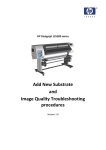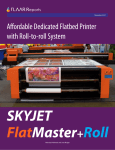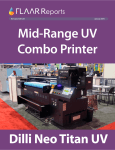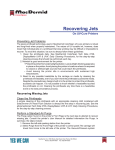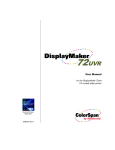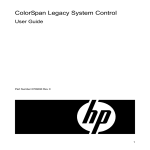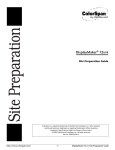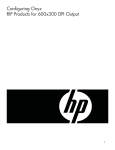Download HP FB910 User's Guide
Transcript
UV Bulb Expectations For HP Scitex FB910 (ColorSpan 9840uv) and ColorSpan Legacy UV Printers 1 Introduction Many customers have questions about the bulbs for the UV-curing lamps on the UV series of printers. This document defines the factors that contribute to bulb wear and what to expect from your UV system. Terminology The UV lamp system consists of these parts: Lamp Housings The two ventilated boxes on the left and right sides of the carriage. Each lamp housing is conceptually equivalent to a light fixture in your home or office: it is a reasonably permanent hardware item. The lamp housing is directly connected to the electrical current and contains the necessary components to light up a UV bulb (see below). The housing also has a self-contained cooling apparatus. Lamp Cassette A carrier for the bulb. The cassette is a circuit board and reflector assembly and has the direct electrical connections for the UV bulb. The cassette is a consumable item, but a reseller or authorized service provider can remove a used bulb and install a new one into the same cassette several times before the cassette must be replaced, or the complete cassette and bulb assembly can be replaced as a unit. Replacement of the cassette and bulb assembly can be performed by any operator and does not require a service visit. UV Bulb The actual “light bulb” that emits visible and UV light energy. Just like a light bulb in any fixture in your home or office, the UV bulb is a consumable item and will eventually need to be replaced. Bulb life is a major topic of the remainder of this document. The photographs below show each of these items (FB910 has slightly different appearance but should be recognizably similar). Lamp Housing on Carriage Cassette Removed from Housing Bulb Removed from Cassette Bulb Life Bulb life is defined as the period in which the bulb will emit enough ultraviolet (UV) light energy to cure the ink within the available exposure time. For the first 200-300 hours of on-time, the energy emitted by the bulbs is constant. After that the energy emission begins to decline. Between 300-500 hours of use, the decline is sufficient so that most bulbs no longer emit enough energy to cure output in the fastest printmodes with the lamp at its lowest power setting. If you are not printing in the faster modes, the number of hours before this occurs may be higher; but see the “Additional Notes on Bulb Life” section (below) for important details. Whenever this point is reached, there are two options to extend the life of the bulb: 2 1. Increase power from low to medium, and then from medium to high. Increasing the power setting causes the bulb to emit more UV energy. Heat output will increase as well, so see the section below about power settings and heat generation. 2. Change to the next slower print mode. Each mode moves the media through the lamp zone at a different rate. Slower print modes allow the printed ink to be exposed to the decreased lamp energy more times, resulting in an accumulation of enough UV energy to cure the ink. At some later time, the energy output even at the high power setting combined with printing in the slowest mode will not expose the ink to enough UV energy to cure. At this point there is no option except to replace the bulbs. The estimated maximum life for a bulb is 1000 hours. Additional Notes on Bulb Life • “On-time” includes all time that the bulbs are on, including when the printer is not actively printing. The setting for idle on-time until automatic shut-off can be adjusted between 1 and 8 minutes. • On-time alone is not the only factor that contributes to eventual energy decline. Each startup cycle of the bulb also contributes to the decline. To maximize bulb life, plan your printing schedule so that both idle on-time and lamp startup/shutdown cycles are kept to a minimum. • Using the manual media measurement method, whereby the printer operator finds the width of the media by manually positioning the carriage over each edge, must turn off the lamps in order for the measurement to take place. This increases the number of startup cycles, which as noted above contributes to decreased bulb energy. Bulb Power Settings and Heat Generation Some customers have observed an increase in “Lamp Overheated or Disconnected” error messages after changing the bulb power setting to Medium or High. Each lamp assembly has a cooling system consisting of two fans that pull air through the top of the lamp housing, blow it over the bulb, and expel it out the side of the housing. The top of the assembly has a filter screen that keeps foreign particles from being blown by the fans onto the bulbs. This filter screen can become clogged, decreasing the air flow over the bulbs and therefore decreasing the efficiency of the cooling system. The Medium and High power settings create more heat than the Low power setting, and so if the cooling system is operating at anything less than peak efficiency, the temperature could exceed the safety limit and cause the lamp to turn off. 3 © Copyright 2008 Hewlett-Packard Development Company, L.P. The information contained herein is subject to change without notice. The only warranties for HP products and services are set forth in the express warranty statements accompanying such products and services. Nothing herein should be construed as constituting an additional warranty. HP shall not be liable for technical or editorial errors or omissions contained herein. TN2760D 4




